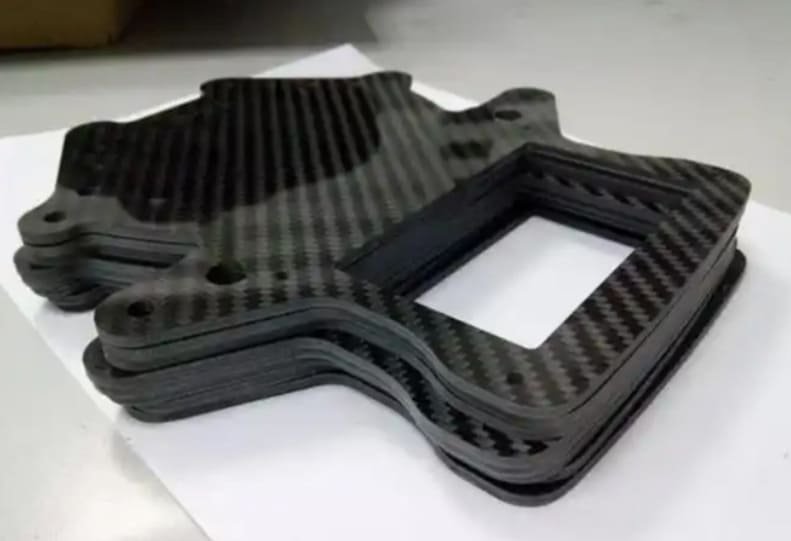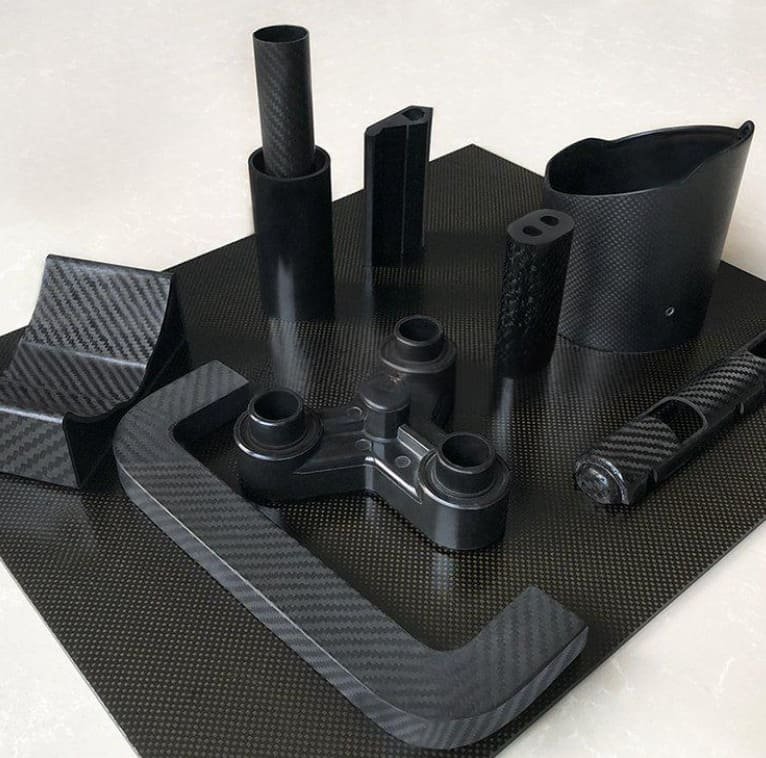
Precision Carbon Fiber CNC Machining
CNCPOR specialized expertise in machining carbon fiber reinforced polymers (CFRP) with the precision and quality your application demands.
Understanding Carbon Fiber CNC Machining
Carbon Fiber Reinforced Polymer (CFRP) is a composite material consisting of carbon fibers embedded in a polymer matrix. This combination creates components with exceptional strength-to-weight ratios, making them ideal for applications where weight reduction is critical without compromising structural integrity.
While carbon fiber offers remarkable benefits, machining this material presents unique challenges that require specialized expertise and equipment. Unlike metals, carbon fiber doesn’t form chips when machined – instead, the material fractures, creating abrasive dust that accelerates tool wear and requires careful management.
Key Properties of Carbon Fiber
- Exceptional strength-to-weight ratio (stronger than steel at 1/5 the weight)
- High stiffness and tensile strength
- Excellent fatigue resistance
- Low thermal expansion coefficient
- Corrosion resistance
- Electrical conductivity
Machining Challenges
- Material relaxation causing dimensional changes
- Risk of delamination and fiber fraying
- Rapid tool wear due to abrasive nature
- Dust management requirements
- Heat generation affecting resin integrity
- Directional properties requiring specialized approaches
CNCPOR's Carbon Fiber Machining Capabilities
we’ve invested in specialized equipment and developed proprietary processes to overcome the unique challenges of carbon fiber machining. Our expertise ensures dimensional accuracy, excellent surface finish, and structural integrity for all carbon fiber components.
Advanced Equipment
- 5-axis CNC machining centers for complex geometries
- High-speed spindles (up to 30,000 RPM)
- Specialized dust extraction systems
- Precision measurement equipment
- Automated tool wear monitoring
Specialized Tooling
- PCD (Polycrystalline Diamond) tooling
- Compression cutters for delamination prevention
- Custom tool geometries for fiber orientation
- Specialized drilling solutions
- Tool life management systems
Quality Control
- CMM (Coordinate Measuring Machine) verification
- In-process inspection capabilities
- Surface finish analysis
- Material integrity testing
- Comprehensive documentation
Carbon Fiber Materials We Machine
Our advanced CNC equipment and specialized tooling enable us to machine a wide range of carbon fiber materials with exceptional precision and minimal delamination.
- Carbon Fiber Composites
- Prepreg Carbon Fiber
- Unidirectional Carbon Fiber
- Carbon Fiber Reinforced Plastics (CFRP)
- Woven Carbon Fiber
- Carbon Fiber Tubes & Sheets

Technical Expertise in Carbon Fiber Machining
Our approach to carbon fiber CNC machining is built on years of experience and continuous refinement of our processes. We understand the unique characteristics of carbon fiber and have developed specialized techniques to achieve optimal results.
Overcoming Common Challenges
| Challenge | CNCPOR Solution | Benefit |
|---|---|---|
| Delamination | Specialized compression cutters and optimized cutting parameters | Maintains structural integrity and surface quality |
| Dimensional accuracy | Compensation algorithms for material relaxation | Achieves tolerances as tight as ±0.001" |
| Tool wear | PCD tooling with automated tool life management | Consistent quality throughout production runs |
| Dust management | Advanced extraction systems with HEPA filtration | Clean parts and safe working environment |
| Heat generation | Optimized cutting parameters and specialized coolant strategies | Prevents resin degradation and maintains material properties |
Carbon Fiber Solutions Across Industries
Our carbon fiber machining services cater to diverse industries that require lightweight, high-strength components with precise specifications.
Aerospace
- Structural components
- Interior fixtures
- Instrument housings
- UAV/drone components
- Satellite structures
Automotive
- Body panels and components
- Interior trim pieces
- Chassis components
- Performance parts
- Racing applications
Medical
- Prosthetic components
- Imaging equipment parts
- Surgical instruments
- Orthopedic fixtures
- Medical device housings
Sporting Goods
- Bicycle components
- Golf club components
- Tennis and racquet sports
- Fishing equipment
- Performance equipment fixtures
Industrial Applications
- Robotic components
- Machine parts
- Inspection fixtures
- Specialized tooling
- High-performance industrial applications
Our engineering team can help optimize your design for carbon fiber machining, ensuring maximum performance while minimizing costs.
Your Trusted Carbon Fiber Machining Partner
Combining advanced technology, expert craftsmanship, and rigorous quality control to deliver exceptional carbon fiber components for your most demanding applications.
20+ Years Expertise
Extensive experience in carbon fiber machining with proven track record
- Over 500 successful projects
- Aerospace-grade precision
- Continuous innovation
Quality Guaranteed
AS9100D and ISO 9001 certified facility with rigorous quality control
- 99.8% quality pass rate
- Full traceability
- Comprehensive documentation
Advanced Technology
State-of-the-art 5-axis CNC machines with specialized carbon fiber tooling
- Diamond-coated tools
- Real-time monitoring
- Dust-free environment
Fast Turnaround
Rapid prototyping and production with on-time delivery guarantee
- 24-48 hour quotes
- Expedited services
- Just-in-time delivery
Just-in-time delivery
Dedicated engineers and machinists specializing in composite materials
- Certified technicians
- Design for manufacturing
- Technical support
Global Reach
Serving customers worldwide with consistent quality and service
- International shipping
- Local support
- Multi-language service
Carbon Fiber CNC Machining FAQ
Get answers to common questions about our carbon fiber machining capabilities, processes, and services.
Carbon fiber composites are characterized by high strength, low density, and high brittleness. During machining, special tools (such as diamond-coated tools) and lower cutting speeds must be used to avoid material delamination and cracking. In contrast, metal machining places more emphasis on hardness matching for tool wear and cutting force requirements, resulting in significant differences in overall machining parameters.
Prepreg carbon fiber sheets, carbon fiber woven cloth laminates, carbon fiber tubes, and carbon fiber molded parts can all undergo CNC machining. Among them, laminated materials with a high degree of homogenization yield more stable machining results, with less likelihood of burrs or delamination.
Delamination is mostly caused by excessive cutting speed, dull tools leading to excessive cutting force, or insufficient interlayer bonding strength of the material. Solutions include reducing the feed rate, replacing with sharp tools, and optimizing the machining path (e.g., cutting from the edge to the center).
There are certain requirements. Carbon fiber materials are prone to moisture absorption. It is recommended that the humidity in the machining environment be controlled between 40%-60% and the temperature maintained at 20-25°C to prevent dimensional instability of the material due to humidity changes, which could affect machining accuracy.
During machining, special fixtures must be used to fix the tube, ensuring that both end faces are perpendicular to the spindle axis. It is advisable to first rough machine both end faces to level them, then use a symmetric cutting path to machine the outer circle or inner hole, avoiding tube deformation caused by uneven stress.
Yes. Special taps are usually used for tapping. A pre-drilled hole is required before machining, and the diameter of the pre-drilled hole must be accurately calculated (slightly larger than that for metal threaded holes). During tapping, reduce the rotational speed and use cutting fluid (such as special carbon fiber cutting oil) to prevent tap wear or hole wall cracking.
Deformation is mostly caused by the release of internal stress in the material or accumulation of cutting heat. It can be reduced by pre-aging the material (to eliminate internal stress), using a cooling system to control cutting temperature, and optimizing fixture design (to avoid excessive clamping).
Yes. Machined carbon fiber parts can be assembled with metal or other material parts through structural adhesive bonding or mechanical connection (such as bolt fixing). During CNC machining, positioning holes or mounting surfaces can be reserved to ensure assembly accuracy.
- contact us
Request Your Carbon Fiber Machining Quote
Ready to get started? Contact our engineering team for a detailed quote and technical consultation for your carbon fiber CNC machining project.
- Quick Quote Within 2 Hours
- Orders From 1 Pc To 10,000+ Pcs
- 24/7 Engineer Support
Request A Quote
- All information and uploads are secure and confidential.
